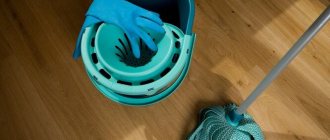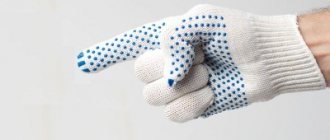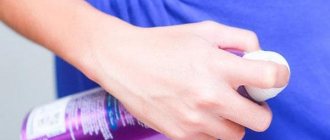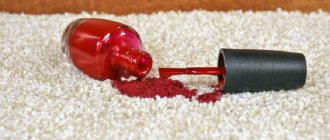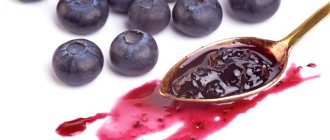In spring, poplars swell with buds that secrete a yellow sticky substance. Therefore, many are interested in a method that will allow them to remove poplar stains from clothes. After all, in the spring it is very easy to get dirty, and a simple walk in a park or poplar alley can result in dirt on things that is difficult to remove. You can use store-bought medications, although experienced housewives claim that you can remove intrusive Velcro using improvised means.
Leather
If resin from poplar buds gets on leather items, you need to:
- Soak a piece of cloth in turpentine and rub the stained area.
- Then soak a piece of cloth in gasoline and apply it again to the problem area.
- You need to keep the solution on the stain for no more than 2 minutes, otherwise it can “eat away” a thin layer of leather fabric.
- Wipe the area with water.
After such a procedure, you need to hang the item in a cool, open place, for example, on a balcony, and leave it there for a day.
How to wash poplar from clothes?
In spring, poplars swell with buds that secrete a yellow sticky substance. Therefore, many are interested in a method that will allow them to remove poplar stains from clothes. After all, in the spring it is very easy to get dirty, and a simple walk in a park or poplar alley can result in dirt on things that is difficult to remove. You can use store-bought medications, although experienced housewives claim that you can remove intrusive Velcro using improvised means.
Popular means
In addition to gasoline, turpentine and the usual Fairy, there are other means with which you can solve the problem of how to remove stains from poplar buds and bring your favorite things back to life.
The well-known Domestos will suit everyone. It contains chlorine, which will help get rid of sticky tar stains, but this method is only recommended for white items. After all, chlorine is a typical bleach. And the main thing is not to overdo it.
There is a thermal method for removing stains from poplar buds. To do this, you need to heat the stain until the resin melts, absorb it with a paper napkin, and wipe off the residue with acetone. This is a wonderful alternative to freezing, more labor-intensive, but also much more effective.
The well-known stain remover VANISH is also suitable, but only for soft fabrics; it does not wash thick fabrics. To remove a stain, you need to take 1 spoon of stain remover, dilute it with water in a 1:1 ratio and pour it on the stained area. Wait 30 minutes and wash in a washing machine on a delicate cycle.
Amway stain remover spray can also help a lot with this difficult situation.
Machine wash: 4 rules
The washing machine will remove dirt not only from the sole, but also from the entire surface of the sneakers. However, the method is only suitable for good quality rag products. Suede or leather shoes cannot be machine washed. This doesn't just apply to sneakers. For example, leather sandals will lose their shape irrevocably after spinning in a drum. Also, do not put low-quality shoes into the drum - they will come apart in the machine or come apart at the seams. If machine washable, follow these four rules.
- Special bag. Use a special bag for washing shoes. This reduces the risk of damaging the drum or the shoes themselves. Alternatively, use a scrap pillowcase or wrap your sneakers in a piece of white fabric and tie it in a knot.
- Choosing washing powder. Depending on the color of your sneakers, choose a powder for colored or white laundry. For pure white sneakers, add bleach.
- Washing mode. Wash on a sports shoe or delicate cycle at a temperature not exceeding 30°C.
- Spin mode. Press at minimum speed.
The machine cleaning method does not greatly affect stubborn dirt and old stains on the white sole. The machine will only refresh the color and remove fresh dirt. The rest will need to be cleaned with additional means.
Handy methods
Lemon juice is used as a means of removing yellowness from fabric after removing stains. You need to apply freshly squeezed liquid to the desired area and leave for 10-15 minutes. Then rinse and wash the item again. There will be no trace of yellowness left.
You can also use laundry soap. To do this, grate half the bar, add half a spoon of soda ash, put the pulp on the stain and leave for 20 minutes. All that remains is to rinse and wash.
For old and forgotten stains, hydrogen removal is suitable. You need to remove the top layer of dried adhesive with a wooden spatula, pour in peroxide, after the reaction has passed, soak the product in warm soapy water, and then put it in the washing machine.
What are poplar buds made of and what are their medicinal properties?
The kidneys contain:
- caffeic acid - found in all plants;
- gallic acid is an organic acid found naturally in tea, oak bark, thunbergia, and tanning extracts;
- malic acid is a dibasic hydroxycarboxylic acid. Colorless hygroscopic crystals, highly soluble in water and ethyl alcohol;
- essential oil (about 0.7%) - an odorous mixture of liquid volatile substances isolated from plant materials;
- tannins - waste products of plants;
- gum - polymers of monosaccharides soluble in water or swelling in it - glucose, galactose, arabinose, rhamnose, uronic acids;
- salicin is a crystalline glucoside with a bitter taste, neutral reaction, difficult to dissolve in cold water and alcohol, easier in hot water and hot alcohol;
- tannins - have tanning properties and a characteristic astringent taste.
Related article Tatyana Ressina: How poplar fluff added to city residents' allergies
Poplar buds have a number of medicinal properties. Our ancestors knew about this.
In Ancient Greece, an ointment was made based on poplar buds for the treatment of hemorrhoids and gout. In the 17th–18th centuries they were used to treat ear diseases and skin diseases, including burns and arthritis. Today, poplar buds are used as a remedy in both folk and official medicine. They are part of the Riga balsam. Poplar buds act as an analgesic, antipyretic, anti-inflammatory and blood thinner.
Traditional methods
There are also folk methods that will help solve the problem of how to remove stains from poplar buds. To do this you will need half a piece of tar soap and a decoction of milk thistle stems.
It is necessary to soap the stain with tar soap and soak the item in the broth. After a couple of hours, take the product out, rinse and dry. The stain was gone.
Grape vinegar is also a good remedy for solving the problem of removing stains from poplar buds on clothes. You need to fill the required area with a similar liquid for 5 minutes, and then wash the item.
There are some exceptions in the fight against the stickiness of poplar buds. If a stain appears on synthetic fabric, you cannot use chlorine, alcohol and acetone, since the item may become deformed and even holes will remain on it. Therefore, the question of how to remove buds from a poplar must be approached responsibly.
The main difficulties in removing stains
To understand what means can be used to treat stains from linden and poplar buds, you need to understand a little deeper what the resin of these trees represents.
In composition, it is a combination of several polymers that can firmly and very quickly eat into any surface. Absorption into the fabric occurs instantly, so many housewives know that dealing with traces of resin is a difficult and sometimes almost hopeless process. After all, all washing powders and bleaches are created to remove completely different contaminants, but they are not effective when working with tree resin. Prolonged soaking, frequent washing, and the use of physical force will not help to wash poplar buds.
Substances that can remove traces of poplar and linden buds are solvents that contain acetone and more aggressive components. They enter into a chemical reaction with the resin and destroy traces of its presence on clothing. Substances that can quickly remove traces of linden and poplar buds include:
- Hydrobromic acid is an effective but extremely toxic agent that can be harmful to health. It is not used for household needs, even if there is a need to wash the linden;
- Nitric acid concentrate is an equally hazardous substance that is not suitable for cleaning clothes at home;
- Acetone is a solvent that can be used to remove linden or poplar buds from clothes, but you must follow the rules of use;
- Sodium hypochlorite is a chlorine bleach that is often used to remove a variety of stains on white fabrics, including linden and poplar buds.
Among the products that can certainly cope with the task, there are only two that, although with extreme caution, can still be used to clean clothes stained with linden. Do not forget that they can only help with minor stains and only on the condition that the fabric that will be processed is of high quality and durable.
Cleaning Recommendations
To reliably remove Velcro from poplar, try to begin the procedures as soon as you notice the problem. After all, it is known that fresh stains are removed easier and faster. Select cleaning products carefully, as some formulations are not suitable for the type of fabric and will only damage the material.
For synthetics and colored items, it is not recommended to use ammonia, acetone and bleaches containing chlorine, otherwise the clothes will fade and become deformed. Such compositions are suitable for white natural fabrics, for example, cotton or linen.
It is known that poplar and other resins dissolve in concentrated nitric and hydrobromic acid. But these compounds should never be used on clothing, otherwise they will leave holes in the fabric.
Recommendations
In most cases, it is easiest to wash off only fresh stains, but synthetic detergents will help get rid of old and forgotten ones.
The resin from poplar buds penetrates and eats into tissues very quickly; it must be removed as soon as possible. Different types of fabrics have their own methods for removing stains.
What to remember
- The fresher the stain, the easier it is to remove.
- Be sure to test the product on an inconspicuous area of fabric.
- Take precautions.
- Do not use solvents on delicate or acetate materials.
Resin is an amorphous substance of plant or synthetic origin, which under normal conditions is in a solid state, but melts when heated. You can get dirty in it in a forest or city park, on an asphalt road, or while repairing electrical wiring using rosin. Due to their complex structure, resin stains are difficult to remove. But don’t worry, there are effective methods to combat them. Let's figure out how to remove resin from clothes at home.
Before you wash the resin from your clothes, you need to perform several manipulations. First, scrape off the main layer of the substance using a knife (dull side) or spoon. Be careful not to stretch the fabric or rub resin contamination into the fibers.
After preliminary cleaning, the item with the stain must be wrapped in plastic and placed in the freezer for 60-90 minutes. The resin will harden and become brittle. If you crush it, it will crumble into small pieces. Residues can be removed with a brush. What to do with a large item that cannot be put in the freezer? Rub the tar stain with an ice cube several times to harden it.
In most cases, scraping off the resin and placing it in the freezer will still leave a mark on the fabric. Let's figure out how to remove tar stains from clothes using improvised means. But first, here are some general tips:
- Use a dry brush to remove dirt and dust from the fabric to prevent streaks and new stains from forming;
- if the product has a lining, then it must be carefully ripped open and only the layer contaminated with resin must be processed;
- the material where the trace of resin is located should be placed on a hard surface, the best option is a board wrapped in an old cotton napkin;
- A clean cloth around the resin needs to be wetted and also sprinkled with starch (talcum powder) so that the stain does not “spread” when cleaning.
Important: Exposure to cold is unacceptable if the item is made of thin, delicate fabric. Creases during further mechanical cleaning can lead to damage to the fibers.

